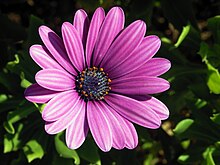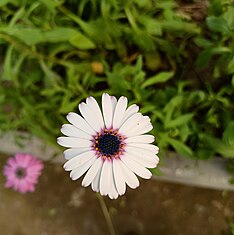Dimorphotheca ecklonis
| Dimorphotheca ecklonis | |
|---|---|

| |
| Scientific classification | |
| Kingdom: | Plantae |
| Clade: | Tracheophytes |
| Clade: | Angiosperms |
| Clade: | Eudicots |
| Clade: | Asterids |
| Order: | Asterales |
| Family: | Asteraceae |
| Genus: | Dimorphotheca |
| Species: | D. ecklonis
|
| Binomial name | |
| Dimorphotheca ecklonis | |
| Synonyms[1] | |
Dimorphotheca ecklonis, also known as Cape marguerite, African daisy, Van Staden's river daisy, Sundays river daisy, white daisy bush, blue-and-white daisy bush, or star of the veldt is a perennial[2] ornamental plant that is native to South Africa. They are part of Asteraceae family [3]. They are common gardening plants due to the array of colors the come in, including yellow, orange, purple, white and pink.[4] They are cultivated in suitable climates as ornamental plants, but are native to South Africa.[4] They are now regarded as an invasive plant in parts of Australia, particularly Victoria and Western Australia.[5]
Features[edit]

They are an evergreen, perennial dwarf shrub with the stature heights of 20 to 60 centimeters.[6] The leaves measure 5 to 10 × 1 to 4 inches and are glandular fluffy, sessile, elliptical, slightly succulent, narrow obovate and entire or serrated. The heads are on 15 to 20 centimeters long stems and have a diameter of 5 to 8 centimeters. The bracts are 13 to 16 millimeters long and glandular. The rays are white above and reddish blue below. The disc is dark blue or purple. The fruit surface is net-wrinkled.[7]
The flowering period is from April to September in the northern hemisphere. The plant is said to contain hydrocyanic acid, making it poisonous to livestock.[8]
They are useful model organism for experiments because of traits like ability to grow quickly and all year round. They can also be used as UV indicators because they're phototropic and sensitive to radiation. [9][10]
Distribution[edit]
When found naturally the plants can be seen growing at the base of cliffs or on steep hills.[11] They are native to the Eastern Cape in Uitenhage and Humansdorp, in South Africa, and is found on wet grass and in river beds at altitudes up to 300 meters. They prefer subtropic biomes but has been introduced into the Azores, California, Mauritius, New South Wales, Queensland, Réunion, Spain, Tunisia, Victoria, and Western Australia.[12] They have become popular in Europe in places like Sicily, Italy.[13]
Cultivation[edit]
They can be grown as perennial but based on the temperature swings of the climate it can be annual.[14] Based on the climate they tend to bloom late spring to summer, after rain and when the weather is hotter.[15][16]
Currently, They are widely used as an ornamental plant in pots and beddings.[17] In places like Australia where they have become invasive, the white colored flowers are ground cover plants.[18] They are cultivated once a year. There are numerous hybrids and varieties, including upright, up to 1.5 meters high and half-low. This species has been in culture since about 1920. It thrives best in full sun, in poor, sandy soil.
Germination
The seeds tend to germinate in 15–20 days and prefer light watering and fertilizing.[16] It is suggested that seeds are planted 6–10 inches from one another.[16][15] For the best development of seeds put them in a area with maximal light.[19] They will grow best in cooler temperatures.[16][20]
References[edit]
- ^ "Dimorphotheca ecklonis". Plants of the World Online. Royal Botanic Gardens, Kew. Retrieved 24 April 2024.
- ^ "Osteospermum ecklonis – FNA". floranorthamerica.org. Retrieved 2024-04-05.
- ^ "Dimorphotheca". www.osteospermum.com. Retrieved 2024-03-24.
- ^ a b "Livingstone Daisy". HowStuffWorks. 2007-04-05. Retrieved 2024-03-24.
- ^ Eckehart J. Jäger, Friedrich Ebel, Peter Hanelt, Gerd K. Müller (ed.): Rothmaler. Excursion flora of Germany. Volume 5: Herbaceous ornamental and useful plants . Spektrum Akademischer Verlag, Berlin Heidelberg 2008, ISBN 978-3-8274-0918-8 .
- ^ "Livingstone Daisy". HowStuffWorks. 2007-04-05. Retrieved 2024-03-24.
- ^ Munz, PA 1968. Suppl. Calif. Fl. 1–224. University of California Press , Berkeley.
- ^ "Dimorphotheca ecklonis | PlantZAfrica". pza.sanbi.org. Retrieved 2024-03-07.
- ^ Ávila-Avilés, R. D.; Torres-Gómez, N.; Camacho-López, M. A.; Vilchis-Nestor, A. R. (2020-10-06). "SERS activity of hybrid nano/microstructures Ag-Fe3O4 based on Dimorphotheca ecklonis pollen grains as bio-template". Scientific Reports. 10 (1): 16633. doi:10.1038/s41598-020-73615-x. ISSN 2045-2322. PMC 7538885. PMID 33024180.
- ^ Trigona, Carlo; Napoli, Giuseppe; Pasquale, Stefania; Puglisi, Ivana; Baglieri, Andrea; Gueli, Anna Maria (May 2021). "A Plant-Based Sensor for UV-A Radiation Measurements". 2021 IEEE International Instrumentation and Measurement Technology Conference (I2MTC). pp. 1–5. doi:10.1109/I2MTC50364.2021.9459911. ISBN 978-1-7281-9539-1.
- ^ "Dimorphotheca ecklonis | PlantZAfrica". pza.sanbi.org. Retrieved 2024-03-25.
- ^ "Dimorphotheca ecklonis DC. | Plants of the World Online | Kew Science". Plants of the World Online. Retrieved 2024-03-25.
- ^ Barone, Giulio; Bajona, Enrico; Bartolucci, Fabrizio; Cancellieri, Laura; Caruso, Giuseppe; Conti, Fabio; Domina, Gianniantonio; Fascetti, Simonetta; Franzoni, Jacopo; Laface, Valentina L. A.; Pinzani, Lorenzo; Rosati, Leonardo; Scoppola, Anna; Stinca, Adriano; Tilia, Agnese (2023-11-20). "Contribution to the floristic knowledge of Lipari and Panarea Islands (Sicilia, Italy)". Italian Botanist. 16: 59–71. doi:10.3897/italianbotanist.16.113415. ISSN 2531-4033.
- ^ "Growing African Daisies Will Add Bright, Vivid Color in Your Garden—Here's How". The Spruce. Retrieved 2024-03-25.
- ^ a b admin (2015-03-06). "Production Guidelines for Four Crops—Osteospermum, Angelonia, Calibrachoa & Ornamental Sweet Potato (Ipomoea batatas)". Center for Agriculture, Food, and the Environment. Retrieved 2024-03-25.
- ^ a b c d "Livingstone Daisy". HowStuffWorks. 2007-04-05. Retrieved 2024-03-24.
- ^ Giovannini, Annalisa; Zottini, Michela; Morreale, Giacomo; Spena, Angelo; Allavena, Andrea (January 1999). "Ornamental traits modification by Rol genes in Osteospermum ecklonis transformed with Agrobacterium tumefaciens". In Vitro Cellular & Developmental Biology – Plant. 35 (1): 70–75. doi:10.1007/s11627-999-0012-2. ISSN 1054-5476.
- ^ Laura, Marina; Consonni, Roberto; Locatelli, Franca; Fumagalli, Elisabetta; Allavena, Andrea; Coraggio, Immacolata; Mattana, Monica (September 2010). "Metabolic response to cold and freezing of Osteospermum ecklonis overexpressing Osmyb4". Plant Physiology and Biochemistry. 48 (9): 764–771. doi:10.1016/j.plaphy.2010.06.003. PMID 20619667.
- ^ "Dimorphotheca ecklonis | PlantZAfrica". pza.sanbi.org. Retrieved 2024-03-25.
- ^ Bass, Louis N.; Toy, S. J.; Sayers, R. L.; Clark, D. C. (1967). "Storage of Dimorphotheca Sinuata and Osteospermum Ecklonis Seed". Proceedings of the Association of Official Seed Analysts. 57: 67–70. ISSN 0097-1324. JSTOR 23432248.
Bibliography[edit]
- Pink, A. (2004). Gardening for the Million. Project Gutenberg Literary Archive Foundation.
External links[edit]
![]() Media related to Dimorphotheca ecklonis at Wikimedia Commons
Media related to Dimorphotheca ecklonis at Wikimedia Commons
